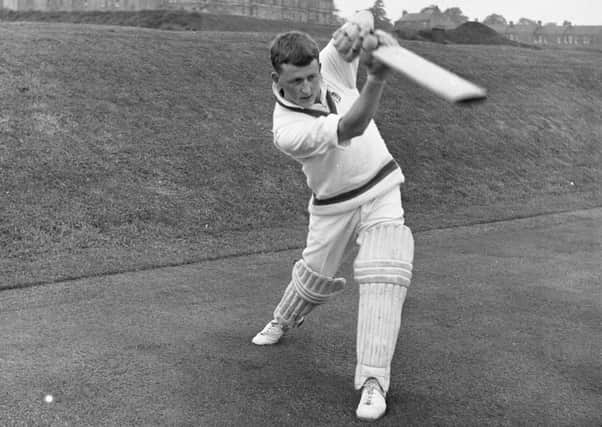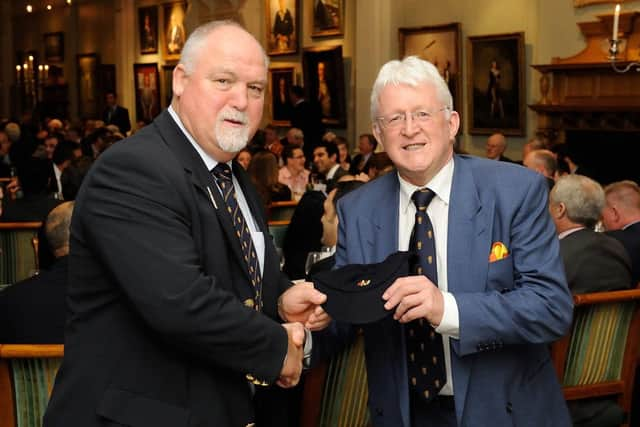Why has Hamish More yet to be inducted into Scottish Cricket’s Hall of Fame?


Hamish More, who was a prolific batsman and a formidable fielder / wicketkeeper during a playing career which spanned five decades, has never been shy about broadcasting his many achievements in the game – which perhaps helps explain why he has yet to be inducted into Scottish Cricket’s Hall of Fame.
“If sportsmen were given marks for tact and taciturnity, Hamish More would, in cricket parlance, be given a pair,” noted legendary sports journalist Norman Mair in 1966. “Winning friends and influencing people ranks low on his list of priorities.”
Advertisement
Hide AdAdvertisement
Hide AdIt should be noted that the posturing is invariably delivered with a healthy dash of self-deprecating humour, for while More, who celebrated his 80th birthday at the end of May, is in no doubt as to his own sporting prowess, he will never be accused of taking himself too seriously.


It is also worth pointing out that his many achievements as a club player for Heriot’s FP, as an internationalist for Scotland, and as a guest of some of the most prestigious invitational sides in cricket, provides his brashness with an authority which is not easily dismissed.
More first came to prominence during four years in the 1st XI at George Heriot’s School in the mid to late 1950s, before transitioning into the FP side at Goldenacre to earn selection for East of Scotland in 1959.
Two years later he was named in a Scotland XI which took on the South African Fezela touring side (an enterprise which was privately funded by sugar industry millionaire E. Stanley Murphy to make amends for the Springboks’ damp squib tour of England the previous year), which was captained by Roy McLean, and listed Peter Pollock, Eddie Barlow, Denis Lindsay, Colin Bland and Kim Elgie amongst their number.
Unfortunately, the Fezela match was wiped out by rain before More had a chance to bat, and in 1962 he suffered a double fracture of his left leg whilst playing rugby, which kept him in hospital for a fortnight and out of all sport for a year. It wasn’t, however, all bad news in 1962, and he still takes great pride in having met the Queen that summer whilst attending the royal garden party as a representative of Scottish Cricket alongside future England captain Mike Denness.
More bounced back from his injury lay-off with some scintillating club form in 1964 and 1965 – including 110 not out against a Melville Colleges attack made up of the lethal triumvirate of Eric Thompson, Dougie Barr and Ronnie Chisholm, as well as a then East of Scotland League record of 149 not out against the Grange – and after a period playing in Somerset, he picked up his first full Scotland cap in 1966, when he scored 50 in the second innings of a three-day match against Cambridge University. “I had to score 13 centuries before my first cap and the reason for that was that I kept telling the selectors they couldn’t pick their nose,” he later surmised.
During the next ten years he played more games (42 out of a possible 44) and scored more runs (over 1,900) than any other Scotland player of the era, which is not bad going in the company of Chisholm, Terry Racionzer, Brian Hardie, Jimmy Allan, Jimmy Brown, Barr, George Goddard and Thompson, all of whom have been inducted into Scottish Cricket’s Hall of Fame.
Family tragedy pushed More to step back from representative cricket in 1976. “My wife, Marie, was diagnosed with terminal cancer and, as I had to look after her and two children under the age of six, I couldn’t practise, although I continued to play on Saturdays,” he explains. “As my batting form had taken a downturn, I decided that I couldn’t do justice to myself or the team by carrying on as an opening batsman, so informed the selectors of that and stopped playing international cricket.
Advertisement
Hide AdAdvertisement
Hide Ad“Four years later, when my children were older, I resumed practice and made a brief return aged 40, playing three games for Scotland in 1980, during their first year competing in the Benson & Hedges Cup.”
It is doubtful that any other amateur Scottish cricketer has been recognised as far and widely outside the country as More, especially during the second half of his career when his wicketkeeping came increasingly to the fore.
He toured Bangladesh with an MCC ‘A’ side (which contained three Test players, ten county players and More) in 1979-80; opened the batting for the first ever British and Irish Amateur XI which played a World Cup warm-up match against Canada at Lord’s in 1974; represented the Scottish Leagues in a Northern Leagues XI alongside Fred Truman and Sir Garry Sobers against a Somerset team captained by Brian Close and containing Ian Botham and Viv Richards at the Harrogate Festival Week in 1975; was selected for T.N. Pearce’s XI captained by Mike Brearley, pictured, and containing seven other England internationalists which inflicted only the second defeat of the tour on Clive Lloyd’s mighty West Indies side at the Scarborough Festival in 1976; and was invited by Graham Gooch to play for Essex in a one-day game against Yorkshire at Middlesbrough in 1985 (when aged 45).
Although he retired from league cricket aged 53, he continued playing midweek and Sunday matches for various sides well into his 70s.
In 1996, aged 56, he made seven stumpings for the MCC in one innings against Hutchesons’ Grammar School, that same year he scored his last senior century playing for the MCC against Batley CC in Leeds, and in 2003 (aged 63) he scored 85 runs in a man-of-the-match performance for a star-studded Lord’s Taverners XI against Scottish club champions Aberdeenshire at Mannofield.
In all, he estimates that he played more than 1,300 matches during his career, which included over 350 games for the MCC, and scored 40 centuries at senior club level or higher (24 for Heriot’s, whom he captained for 13 seasons).
He also had a spell as a selector of the Scotland national team in the late 1980s, which involved managing the side on a number of occasions, including against Pakistan in 1987. In more recent years, the ‘H.K. More Batting Award’ for the ‘International Batsman of the Year’ has been handed out by Cricket Scotland at the end of each season, with the recipient chosen by the Chairman of Selectors, the coach and More himself.
“The 1960s and 1970s really were a boom time in Scottish club cricket, with a lot of very good players indeed, and there is no doubt in my mind that the three best batsmen of that era were Terry Racionzer of Clydesdale, Brian Hardie of Stenhousemuir and Hamish,” recalls his old friend and rival Ian Stevenson of Edinburgh Accies. “They were different in style, but all equally effective, and because of Hamish’s wicket-keeping he just about edges it. It really doesn’t make sense to me that he isn’t in the Scottish Cricket Hall of Fame.”
Advertisement
Hide AdAdvertisement
Hide AdThe sentiment is echoed by George Goddard, his team-mate in both cricket and rugby from schooldays right through their club careers (and in the case of cricket, for Scotland as well).
“At his peak, he was our best batsman, there is no doubt about it,” says Goddard, who captained Scotland between 1974 and 1980. “He was a colourful character, and very sure of his own ability, but he wasn’t a poseur at the crease – he was a really solid opening batsman, and I’ve got to say I was surprised when I realised that he was not in the Hall of Fame because he really was one of the leading Scottish players of that era. He perhaps rubbed a few people up the wrong way at times, but there was no doubt about his ability.”
Over the piece, he played at nine Test match grounds – the six traditional venues in England, two in Bangladesh and Barbados – with Lord’s his undoubted favourite. He played there nine times for three different teams, which must be some sort of record for an amateur player, and still gets a huge buzz when approaching the ground along Wellington Road during his regular visits, where he is always assured a warm welcome from his fellow MCC members.
A message from the Editor:
Thank you for reading this story on our website. While I have your attention, I also have an important request to make of you.
With the coronavirus lockdown having a major impact on many of our advertisers - and consequently the revenue we receive - we are more reliant than ever on you taking out a digital subscription.
Subscribe to scotsman.com and enjoy unlimited access to Scottish news and information online and on our app. With a digital subscription, you can read more than 5 articles, see fewer ads, enjoy faster load times, and get access to exclusive newsletters and content. Visit https://www.scotsman.com/subscriptions now to sign up.
Our journalism costs money and we rely on advertising, print and digital revenues to help to support them. By supporting us, we are able to support you in providing trusted, fact-checked content for this website.
Joy Yates
Editorial Director
Comments
Want to join the conversation? Please or to comment on this article.